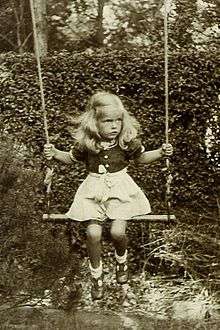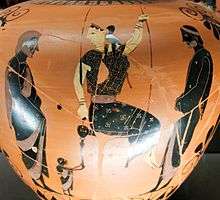Swing (seat)




A swing is a hanging seat, often found at playgrounds for children including adults, at circus for acrobats, or on a porch for relaxing, although they may also be items of indoor furniture, such as Latin American hammock or the Indian oonjal. The seat of a swing may be suspended from chains or ropes. Once a swing is in motion it continues to oscillate like a pendulum until external interference or drag brings it to a halt. Swing sets are very popular with children.
On playgrounds, several swings are often suspended from the same metal or wooden frame, known as a swing set, allowing more than one child to play at a time. Such swings come in a variety of sizes and shapes. For infants and toddlers, swings with leg holes support the child in an upright position while a parent or sibling pushes the child to get a swinging motion. Some swing sets include play items other than swings, such as a rope ladder or sliding pole.
For older children, swings are sometimes made of a flexible canvas seat, of rubberized ventilated tire tread, of plastic, or of wood. A common backyard sight is a wooden plank suspended on both sides by ropes from a tree branch.
Types of swings
Tire swings are a form of swing made from a whole tire. These are often simply a new or used tire hanging from a tree on a rope. On commercially-developed playground swing sets, oversized new tires are often reinforced with a circular metal bar to improve safety and are hung on chains from metal or wooden beams. They may hang vertically or hang flat, suspended from three or more points on one side. The flat version can hold three or more children. Pumping is achieved by using one or two of the three chains attached to the swing, and two (or more) children can pump in turn.[1]
Tire swings can also be used in spinners, where the occupants use their feet to propel the tire.
Natural swings may be created by lianas (creeper plants) in a subtropical wild forest like Aokigahara forest near Mount Fuji.
Rope swings are swings created by tying one end of a length of rope to a tree branch, bridge, or other elevated structure. A knot or loop is usually put on the other end to prevent fraying and help the swinger stay on. Rope swings are often situated so that those swinging on them can let go and land in water deep enough to cushion the fall and to be swum around in.
The incorporation of a short board such as a skateboard in which the rider stands is called swing boarding. It is made safer by the use of an attached board and a harness for the rider.
Baby swings are swings with a bucket shape with holes for the child's legs, or a half-bucket shape and a safety belt, that is intended to reduce the likelihood of a very young child from falling out, however, there have been a large number of well-publicized incidents in which children and adults have become stuck in these swings.[2][3][4][5][6][7]
Porch swing is a swinging, conventionally painted wood, bench-like seat intended primarily for adults. The swing's suspension chains are permanently mounted to the porch ceiling; and the seat is typically large enough to seat about three people, with an armrest at each end. Porch swings are an alternative to using rocking chairs or gliders outdoors.
Canopy swing is similar to a porch swing, but it is hung on a separate frame and is usually portable. The name is derived from a canopy installed as a sun shade.
Kiiking is a sport played in Estonia wherein players attempt to rotate 360 degrees around a spindle, on a long swing consisting of a seat hung with steel bars - instead of with ropes or chains.
Hammock swing is a portable (removable) bed-swing made of lightweight material such as canvas, netting (or as little as two ropes), typically suspended between two trees or attached to a hammock stand.
Dangers
Swings cause some injuries.[8] The most common injury is due to a fall, either by unintentionally letting go of the ropes or chains or by deliberately jumping out of the swing.[8] Less commonly, the person using the swing will bump into or kick another person who is walking or playing too near the swing or, especially with improperly located home equipment, will bump into a fence, wall, or other fixed object. Swings are also associated with strangulation or hanging injuries, usually because the child was wearing a piece of clothing or other item became entangled in the swing.
Swings are the most common cause of injury related to playground equipment at private homes, but a much less common cause of injury in public or school playgrounds, where injuries from climbing equipment dominate.[8] Injuries from swings primarily affect school-age children, but preschool-age children also have a significant risk on swingsets at home.[8]
"Swinging sideways"
The United States Patent and Trademark Office was disparaged in 2002 for issuing a patent[9] to a five-year-old boy who claimed to have invented swinging sideways as a new form of entertainment.[10] His father, a patent lawyer who wanted to show his son how the patent system worked, had told the boy that he could file a patent application on anything that he invented. The patent was rescinded upon re-examination.
Korea

Traditionally Korean women enjoy swinging on the day of Dano (Korean festival).
Gallery
- Estonian traditional swing
 Canopy swing
Canopy swing Kiiking swing
Kiiking swing Rope swing
Rope swing- Three boys are on a tire swing
 Swing made out of tires in East Timor
Swing made out of tires in East Timor Fresco of St Proculus on a swing, 7th century, South Tyrol
Fresco of St Proculus on a swing, 7th century, South Tyrol Tire swing in motion
Tire swing in motion.jpg) Swing on playground, Germany
Swing on playground, Germany
See also
References
- ↑ Tire swings - Information
- ↑ http://www.business2community.com/social-buzz/14-year-old-girl-gets-stuck-baby-swing-friends-humiliate-youtube-0877117
- ↑ http://tokyodesu.com/2014/06/03/girl-gets-stuck-in-baby-swing-desperately-tweets-for-help/
- ↑ http://latimesblogs.latimes.com/lanow/2011/10/california-man-gets-stuck-in-baby-swing-for-nine-hours.html
- ↑ http://web.archive.org/web/20130814234514/http://www.dailymail.co.uk/news/article-2392817/Firefighters-rescue-TEENAGER-stuck-BABY-SWING-tipping-upside-down.html
- ↑ http://www.dailystar.co.uk/news/latest-news/398176/Teenager-stuck-in-playground-swing
- ↑ http://www.huffingtonpost.co.uk/2014/04/10/teenager-shaun-dibsdale-stuck-childs-swing-rescued-firemen-pictures_n_5126127.html
- 1 2 3 4 Tinsworth D, McDonald J. Special Study: Injuries and Deaths Associated with Children’s Playground Equipment. Washington (DC): U.S. Consumer Product Safety Commission; 2001.
- ↑ US Patent 6368227: "Method of Swinging on a Swing". Filed November 7, 2000; granted April 9, 2002; canceled July 1, 2003.
- ↑ Hecht, Jeff (17 April 2002). "Boy takes swing at US patents". New Scientist. Retrieved 1 June 2011.
External links
| Wikimedia Commons has media related to Swings. |